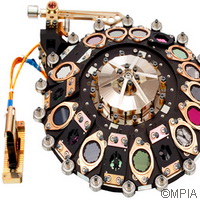European researchers deliver vital component of next-gen telescope
European researchers are once again making sure that their mark will be made, even when it comes to the farthest reaches of space. They have completed the MIRI or the Mid InfraRed Instrument - a pioneering camera and spectrograph so sensitive, that it will be able to see a candle on one of Jupiter's moons. This achievement was commemorated at a special handover ceremony - from the European consortium that constructed the device to the European Space Agency (ESA) - at the Institute of Engineering and Technology in London on 9 May. MIRI will form an integral component of the James Webb Space Telescope (JWST), set to take over duties from the Hubble Space Telescope in 2018. Named after the National Aeronautics and Space Administration (NASA) administrator who was a major advocate of scientific research in space, the JWST will orbit the Sun at a distance of about 1 500 000 kilometres. From this point, known as the L2 Lagrange point, it will be able to orbit the Sun in synchrony with the Earth. From this point, it will train its telescope into the vast depths of space and hopefully capture moments of 'first light' from the very first stars and the formation of early galaxies, as well as offer the opportunity to better examine the birth of stars and planetary systems. The further out into space one looks, the closer one gets to witnessing galaxies formed, and the JWST is expected to see galaxies formed a mere few hundred million years after the Big Bang. Thomas Henning, director at the Max Planck Institute for Astronomy (MPIA) and one of the leaders of the European consortium that built the instrument, explains the technological achievement: 'MIRI is sensitive to a particular range of infrared radiation [at wavelengths of 5 micrometers to 28 micrometers] that will allow us to peer inside the clouds where stars and planets are born - and witness such cosmic births in unprecedented detail. We will be able to examine in detail the swirling disks of gas and dust in which planets are forming!' This ability to capture images in infrared is a major component of the JWST. Images taken using the visible spectrum, while visually amazing, only provides researchers with a partial image of what truly lies out in space, since gas and dust obscure our vision. Infrared, on the other hand, has the ability to pierce through such dusty barriers, and can provide us with images of these hidden stars. Aside from peering into the farthest depths of space, the JWST is also perfectly suited to exploring planets in our own solar system, comets, and objects in the Kuiper belt. This is because relatively cool objects primarily emit their radiation in the infrared spectrum, where they are better observed. Other stellar objects that need to be studied in the infrared spectrum include brown dwarfs and clouds of the interstellar medium - which can include gas in ionic, atomic and molecular form, dust, and cosmic rays. More than 200 scientists and engineers put more than 10 years of work into developing MIRI, overcoming several technical challenges in the process. Oliver Krause headed a team at the MPIA Infrared Space Astronomy group that developed a number of solutions, one of which involved the mechanics for a filter wheel. Oliver Krause explains: 'MIRI is a very versatile instrument - you can insert a number of different filters and other elements that allow MIRI to perform different kinds of measurements, such as taking images and spectra. But when it comes to space telescopes, even something as simple as positioning a filter very precisely in front of a detector is a major challenge. The filter wheel will experience major shaking during the launch of the Ariane 5, and then will need to work very accurately for years on end, without maintenance, at a temperature of -266 degrees Celsius.' Objects travelling into space have to survive the trip out of earth's atmosphere, and then operate in a temperature close to absolute zero, -273 degrees Celsius. Following the special ceremony in London, MIRI will travel to NASA's Goddard Space Flight Center in Maryland in the United States in an environmental container specially designed and constructed to protect it from moisture and keep the temperature stable. Once it arrives, it will begin a two-year testing phase to ensure that its integration with the other instruments of the JWST is successful and ready for launch in 2018.For more information, please visit:ESA:http://www.esa.int/esaCP/SEMIU8TWT1H_index_0.htmlMax Planck Institute for Astronomy:http://www.mpia.de/Public/menu_q2e.php
Countries
Germany



